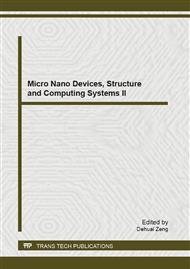p.31
p.36
p.42
p.49
p.55
p.61
p.69
p.74
p.79
Characterization of HCl-Doped Polyaniline-Ag Nanocomposite Prepared by Chemical and Physical Combinative Method
Abstract:
HCl-doped polyaniline (HCl-PANI) powder is synthesized by using a chemical polymerization procedure. Then Ag nanoparticles are deposited on the HCl-PANI at room temperature by RF sputtering. After this process, the nanocomposite is obtained by the chemical and physical combinative method. The nominal Ag content in the nanocomposite ranges from 1.0 wt% to 3.3 wt%. For all the nanocomposites, the Ag nanoparticles convert to AgCl nanoparticles. Namely, the HCl-PANI-AgCl nanocomposites are obtained. A content of the AgCl in the nanocomposite increases with increasing Ag content. The AgCl nanoparticle consists of many grains. An average grain size of AgCl is about 40 nm and is independent of the Ag content. A conductivity of the nanocomposite decreases with increasing Ag content.
Info:
Periodical:
Pages:
55-60
Citation:
Online since:
March 2013
Authors:
Keywords:
Price:
Сopyright:
© 2013 Trans Tech Publications Ltd. All Rights Reserved
Share:
Citation:


